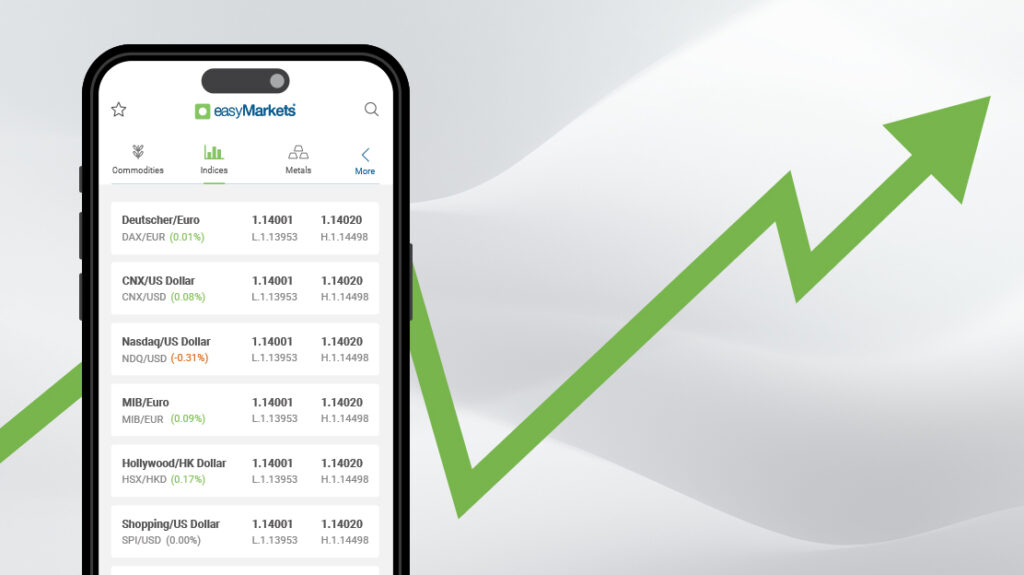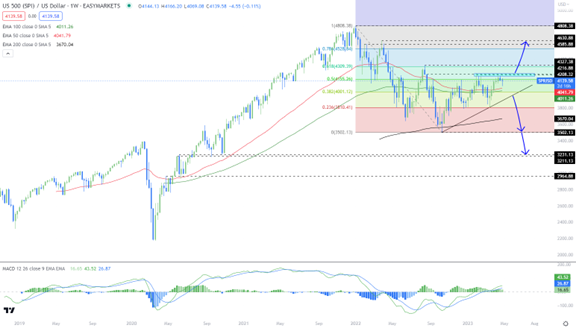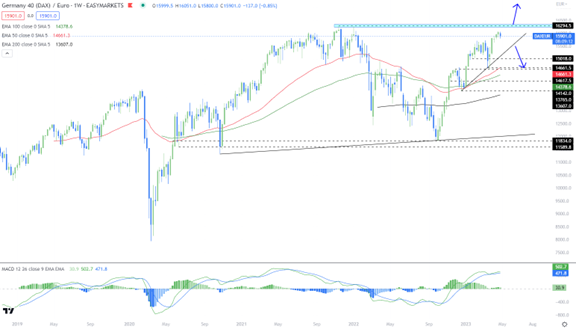
Waiting for a Catalyst
After the sharp Covid-related sell-off we experienced back in March 2020, there were not many believers that the equity market could recover in the medium-term. However, not only that we saw a total recovery of the losses made by the end of the same year, but some major indices also managed to gain even further hitting new all-time highs the year after.
The S&P 500 reached its all-time high in January 2022, coming close to the 5000 mark, but has moved back down since then. At the time of writing the index is oscillating not far from the 4000 territory. The German index, DAX 40, managed to form an all-time high around mid-November 2021, reaching the area near the 16300 zone.
After that, it reversed south and was moving in that direction until the end of September of last year. Despite wiping out some of those gains throughout most of 2022, the index was able to go back to that psychological 16000 mark again by the end of April of this year.
Everything what we have mentioned above indicates that the buyers are not giving up on those indices yet, although the current market negativity surrounding them. Buyers continue to monitor the earnings of major companies, which are still reporting decent results. So, from the near to medium-term perspective, top indices could still come under buying interest.
That said, markets are currently in limbo, waiting for further steps from the major central banks. Even company earnings cannot fully help determine the course that these indices should take. Although the major components of those indices show decent results, they are still not enough to help establish a clear trend.

A Technical View over S&P 500
For example, the S&P 500 shows good volatility, however, the index is in a sideways trend, oscillating around the 50- and the 100-day EMAs on our weekly chart. From around the beginning of September, the price is struggling to stay above the 4200 area, emphasizing the importance of that zone.
If, eventually, the bulls are able to surpass that obstacle, this might clear the path towards the 4300 territory, marked near the highest point of August 2022. That territory is also near the 61.8% retracement on the Fibonacci, drawn from the highest point of January to the lowest point of October of 2022.
The question is, could it continue going higher after that? Yes, it could. Although the Fed is trying to keep the market from accelerating rapidly over the medium-term and to bring inflation back to 2% area, the market might continue adjusting and pushing slowly higher, ignoring Fed’s gradual 25 bps hikes. Certainly, this could continue hurting small-to-medium enterprises, as not all of them would be able to withstand the rise in borrowing costs. So, later down the line, further upside in indices might be subdued, or worse, the direction may shift to the downside.
In terms of the downside on the S&P 500, we would only target lower areas if the index would drop and stay somewhere below the 4000 mark. But even then, we would initially target the 3800 zone and the 200-day EMA on our weekly chart.
The real feast for the bears could start if the S&P 500 continues to slide and falls below the area around the 3500 level, which is near the lowest point of 2022. If that happens, this might open the door for a move towards the 3200 territory, or even the psychological 3000 mark.

A Technical Overview of DAX 40
In Europe, the German DAX 40 is currently near the psychological 16000 zone. This is just a few hundred points away from the all-time high area, reached in the beginning of November 2021, near the 16300 territory. If that area continues to hold and acts as a strong resistance, the bears might take advantage of the higher price and bring the German index down.
Certainly, from the technical perspective, some might start seeing a double top formation, however, we would still be far from getting comfortable with that idea, as the so-called “neckline” could be the long-term tentative upside support line drawn from the lowest point of October 2020. But before it could potentially go all the way there, DAX 40 would have to overcome some key support hurdles first.

A drop below a medium-term tentative upside support line taken from the lowest point of December 2022, could attract more sellers into the game, possibly clearing the path towards the psychological 15000 and 14000 levels. Near the latter, we have the 200-day EMA on our weekly chart, which may provide a temporary hold-up.
Conclusion
In summary, despite the current negativity floating around in the news headlines, the equity market continues to show resilience and grind higher. To shift our attention to some lower areas, we need a catalyst that might trigger a sell-off.
One of the catalysts could be a more aggressive approach on rate hikes from the major central banks. A geopolitical factor may also play its role, but, unfortunately, it is even less predictable than a central bank decision. So, for now, we continue to focus on the interest rates and inflation numbers.